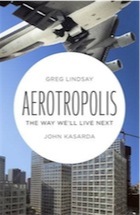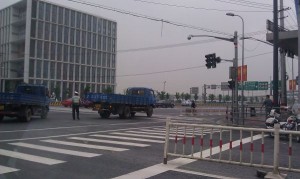
It has been a few weeks since I wrote the last Shanghailander.net post, a delay very much caused by the number of Air Miles I flew in the last weeks. Taking me away from my favorite city and its history, I found myself confronted with its future. This post about New Shanghai if not future Shanghai.
“Aerotropolis, the way we’ll live next” is a book I picked in Bangkok airport a few weeks ago and reading it has been fascinating since. My interest in it surely resonates with my background in transport studies (many years ago now) as well as my recent peak in airmiles flown. The basic theory of John D. Kasarda (the wisdom behind the book) is that cities are drawn around airports because of the need of speed and connectivity. Greg Lindsay (who actually wrote the book) uses many examples of such cities that have been built (mostly in the USA) or are being built (mostly in Asia) around airports.
The aerotropolis seems to be the answer to every problem from global climate change (even demonstrating that flying food around the World is more eco-friendly than growing it locally), to over population (as everybody will be so happy to live in these new mecca of speed and efficiency). Similarly, air transport will fuel the economy of the instant age, as internet purchase rapidly inflate the need for small parcels delivered worldwide as fast as possible. In a same way, facebook and social network will push people to connect face-to-face, using airplanes to bring the gap between continents. The pair finds direct application of their theory in Asia, for example in Singapore that is labelled as the typical aerotropolis. They also find in Bangkok success for passenger traffic, i.e. tourists. At the same time, its failure to create the surrounding aerotropolis environment is also an example of how not to create an aerotropolis from Kasarda’s point of view.

The nearest example to us is surely the new Hong Qiao area. Creating the Hong Qiao 2 terminal, combined with highspeed railway links and the land clearing miles around was definitely inspired by Kasarda’s theories. Just seeing the change in what used to be Puxi’s back waters transformed into the new hot development area is fascinating. Logistics companies, manufacturing and office complexes are all moving Westwards, attracted by this new magnet of competitiveness. Hotels, serviced apartments and residential areas are sure to follow, as all these people will need accommodation short or long term. In that sense, the aerotropolis is just working the way Kasarda predicted it. People are attracted by the airport and its economic opportunities… but whether it is really where people want to live is a different story. This probably the limit to the theory (see The Guardian review of the same book) as living in the aerotropolis seems more like living in Fritz Lang’s Metropolis than in new found paradise.
This is all good for Old Shanghai anyway. As the pressure to create new offices and residential real estate moves form the city center to the peripheral areas, it is likely that the destruction of our beloved city will slow down. Once money made, the winners of this new game will surely move to nicer areas like the Bund or the old French Concession. By contributing to their gentrification, they will hopefully want to protect their new found little paradise and help keeping part of Old Shanghai intact.